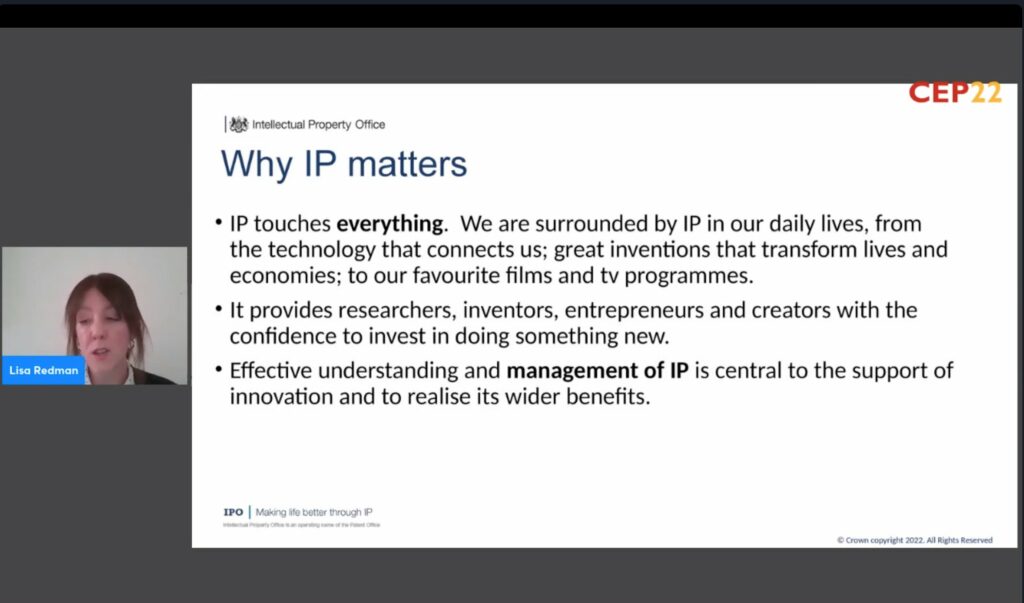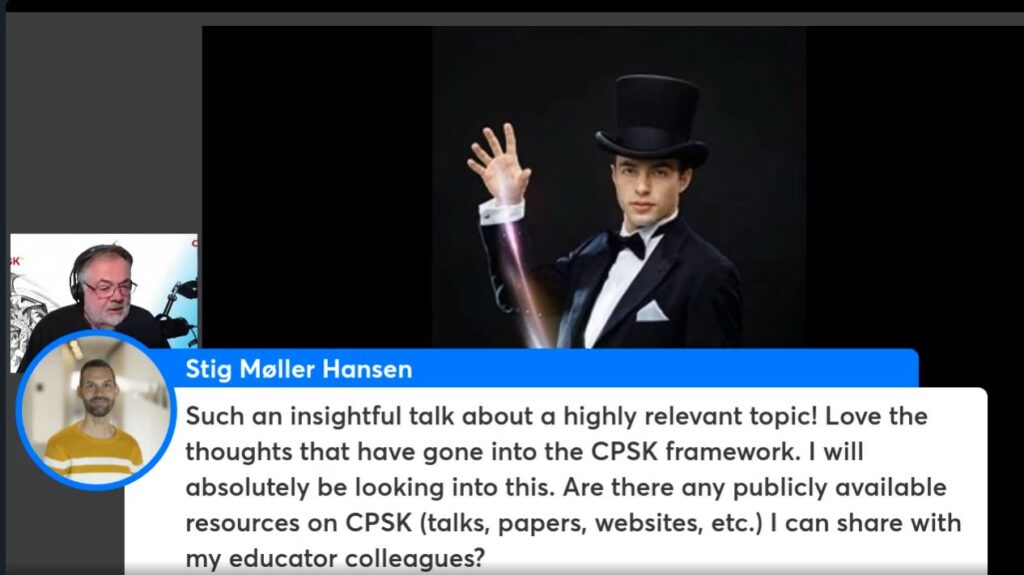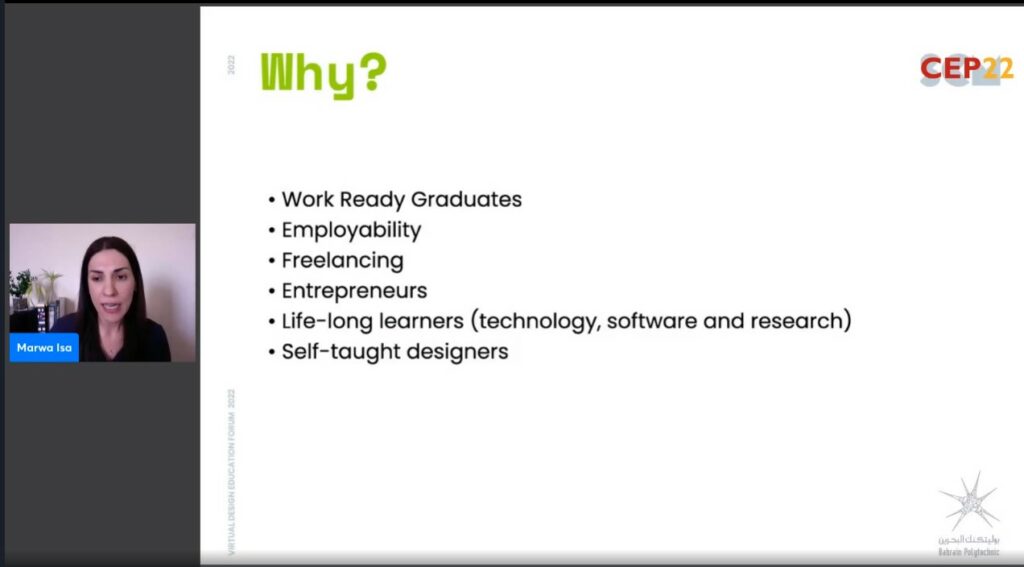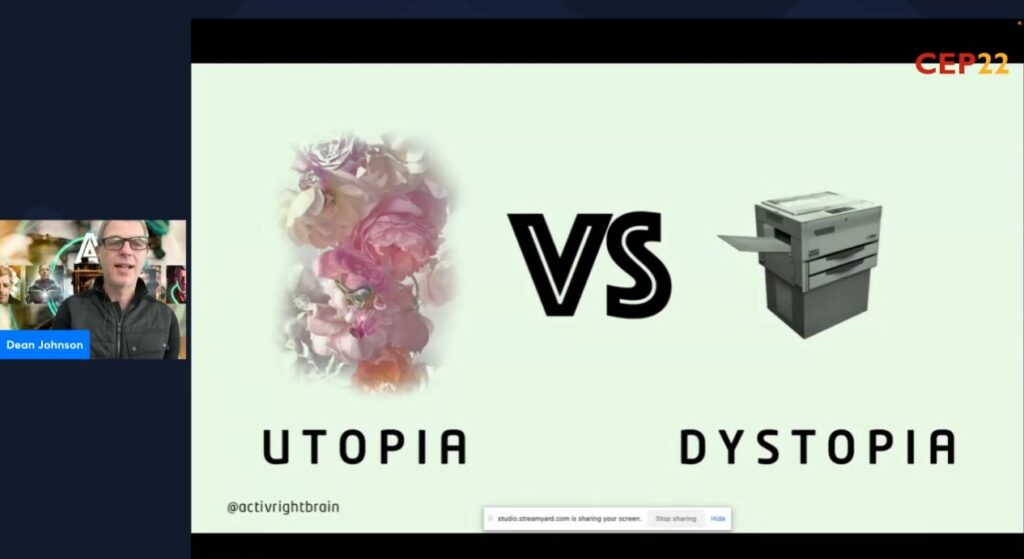30.11.2022
CEP22 – Event Roundup
If it’s design practice – it’s design education
This November, we hosted our inaugural CEP22 forum, which took place on the third day of the VDEF22. The one-day forum brought together design practitioners, tutors and students to discuss how design practice and design education are and can collaborate.
Our Chief Executive, Frank Peters, opened the forum with a keynote on how the Society developed its CPSK™ framework, which underpins the Society’s international education initiative Course Endorsement Programme (CEP), stating that: “a profession can’t be subjective; it has to be objective.”
Frank spoke about how the CPSK™ framework, and the Society as a whole, work to shift the focus from portfolios and outputs and instead move it toward designers and their processes, explaining that “designers speak their own language, a visual language, the language of design”.
During the keynote, Frank shared sketches from the Society’s design process while developing the CPSK™ framework. He noted that the framework had been designed and developed to manage membership and CPD systemically.
On CPD, Frank discussed how the framework helps support designers in continuing their professional development, showing the CPD audit available to all the Society’s members, allowing them to grow and plan their skills development on an ongoing basis. Similarly, he spotlighted our Knowledge Bank, which shares different resources that can support members’ CPD journeys, no matter the stage of their careers.
On professional practice:
- Following this, our President, Jake Leith PCSD, shared his views on how and why professional practice should be included in the learning experience. When considering whether professional practice should be a stand-alone module or included in studio practice, Jake urged that there is a strong argument for both.Throughout his talk, Jake focused on the connection between design and marketing, claiming: “to make any campaign work, these two departments need to work hand-in-hand”.
- Next up, Marwa Isa from the CSD Accredited programmes at the School of Creative Media at Bahrain Polytechnic furthered the discussion on professional practice, sharing how the university has shifted the focus of its design education to incorporate better business acumen. She explained how vital frameworks, such as the Society’s CPSK™, are for education.Marwa also explained how she positions professional practice to her students, especially those who are resistant, saying, “be open to change; we’re here to support you”.
Building on this, she tells her students, you cannot find everything on the web…think like there is no Google! For example, go to the supermarket for a packaging design course and observe.”
- Providing another international viewpoint from a CSD Accredited programme, Massimo Imparato aCSDf of Xi’an Jiaotong-Liverpool University (XJTLU), continued discussing how to embed professional practice in design education. To open his talk, he contextualised the real-world landscape designers are working within, stating “design education, as design practice does not exist alone”, before sharing examples of opportunities within XJTLU in experimenting with practice-based research.

Intellectual Property
- A key focus of the day was on IP and how it impacts designs, and why this must be understood by professional designers. Lisa Redman, Policy Advisor at UK IPO and CSD partner, paved the way for this conversation stating, “as designers, or design students, you need to understand all types of IP, as design engages with all of them”Lisa shared many free online support tools to support designers and students provided by the UPO, including IP Tutor, which the Society has validated.
- Martin Darbyshire FCSD founder of design consultancy, tangerine, built on this discussion, sharing practical examples of the importance of IP in practice and education. He explained the power of patents and showcased real design examples of IP, explaining: “the price of success is that you are going to get copied by others…Patents and Design Registration safeguard a designer’s business and success.”
- Next, Peter Bosson PPCSD, shared the commercial realities of design practice and how they can be embedded into design education, saying, “if you run your own business, you need to know how to get out of it. Having intellectual property can clinch it.”
The impact of AI
In his fascinating keynote about the impact of AI on Design Practice & Education, Dean Johnson FCSD, began by explaining the practical side of how AI technology works, stating that “artificial intelligence is not overly intelligent”. He explained how “designers are creating incredible things, and the AI is referencing incredible things.”
Throughout the discussion, Dean weighed up the pros and cons (or, as he framed it, the ‘utopian’ and ‘dystopian’) of AI.
AI: Utopia or Dystopia for designers?
From a utopian point of view, Dean explained how AI could support a designer’s brainstorming or conceptualising and give designers content at the beginning of a creative thought process. Similarly, he explained that many designers are perfectionists, but “if you’re always chasing perfection, the likelihood is you’ll never achieve that… it’s important to know when to say ‘that’ll do…” – he explained that AI could take care of the “that’ll do” things so that designers can spend more time on the bigger picture work.
Moving onto the dystopia, Dean continued to explain how AI works and why there are fundamental issues with this. He discussed how if AI references AI, rather than real-world designers and artists, outputs can be uncanny, odd, and not fit for purpose, saying, “an issue we’re currently facing is that we’re diluting the gene pool of creativity”.
Rounding up his keynote, Dean asked, “is the question ‘AI vs designer’ or is it ‘AI & the client vs designer’? When considering the real-world implications of AI for designers, Dean explained that the greatest challenges come from two places: mainstream media and creative agencies & internal marketing teams.
Ultimately, Dean explained that designers love what they do, and this is where they add more value than AI ever can, claiming that designers are the fundamental driving force behind creativity “the AI works for us. We don’t work for the AI”
Design accessibility
- Marc Powell, Accessibility Innovation Lead at RNIB, gave an insightful talk on how design can be accessible to all. He shared his first-hand experiences of using technology to interact with real-world spaces and how design impacts this, explaining, “if apps are not designed with accessibility functions in mind, then this affects our purchasing decisions.”He shared a project RNIB worked on with Kellogg’s to ensure packaging is accessible for everyone. Explaining how initially, they wanted to utilise Braille, but that “not many people know, but only 10% of blind or partially sighted people can read Braille.”
- Next, Julian Maynard FCSD, founder of Maynard Design, put a spotlight on inclusion in practice, talking about his experiences with accessibility & design. Julian discussed his recent work on Transport for London’s Elizabeth Line, explaining how they needed to create new seats and how his team considered user experience on the underground throughout this complex project.
- Saiba Quqandi, a PhD research student at Cranfield University, explored her studies into how ageing is considered in design and the importance of user-centred design. Saiba explained how assistive technology is defined and discussed the societal issues that lead people to shun and reject these tools. She concluded that we need to change our approach to assistive technology by using user-centred design to encourage users to interact with the product rather than be passive.
- Rounding up the discussion, Professor Mohammad Nurunnabi of Prince Sultan University discussed the university’s work to embed UN Strategic Development Goals into education in Saudi. He shared how since the launch of KSA Vision 2030 in 2016, the Kingdom has taken significant steps to scale up its climate action and environmental protection.
Rounding up the day, Frank Peters highlighted the theme of the forum, ‘If it’s Design Practice – it’s Design Education’ and that the day had provided some fascinating takeaways for practitioners, educators and students. The speakers had delivered a variety of insights from different design disciplines and cultures, and the panels had explored those insights in depth. Before thanking all of the speakers, panels and attendees, he mused that the one-day forum had actually thrown up topics for at least another five conferences and so was looking forward to CEP23.



